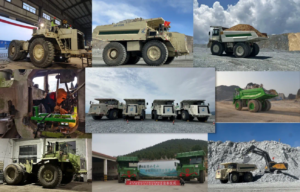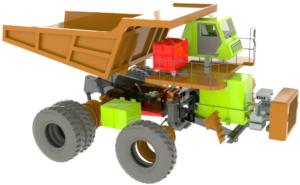Batteries to BEVs
HATL has developed its own wide body battery mining trucks for open pit mining ranging from the 60 t class HC90EA and HC90EB, to the 70 t class HC105E and 85 t HC135E. The largest model has a battery capacity of 704 kW/h and motor power/rated peak of 560/800 kW. All the models use a 6 x 4 configuration. HATL also offers a 20 t class underground BEV truck, the HC33E. The HC105E has seen wide success including at the Shaoguan polymetallic mine in Guandong, which includes underground and surface operation; plus the Fengkai granite quarry in Guangdong. Other projects using the HC105E are the Mozhu Gongka copper-moly mine in Tibet province at over 5,000 m where each HATL truck can reduce CO2 emissions by 0.77 t per day. At the Shanghang gold-copper mine in Fujian the trucks have achieved over 95% availability in challenging conditions. HATL trucks are also used at the Hengyang iron ore mine in Hunan Province.

HATL’s new equipment including the HC105E battery wide body mining truck, is already being widely adopted
These models combine a mature chassis design with a newly designed battery system, electric drive, cooling system, auxiliary system and vehicle control system. HATL says it has applied for 33 patents and was involved in the formulation of five industry standards including technical conditions and test methods for pure electric off highway wide body mining trucks. It has two sets of independent braking systems – mechanical and electric to provide redundancy. Annual energy consumption is about 70% less than diesel with feedback energy greater with loaded downhill operation. Annual parts costs are estimated at 30-35% less plus maintenance labour intensity is reduced. The traction motors offer superior acceleration and smooth driving plus at lower speeds having high torque. Battery operation reduces vibration and therefore impact on the frame. The motor output is more linear with less impact on the transmission system. CAN-based comms are used which can monitor the running status of the vehicle in real time and recommend and make adjustments. Wire control modules are an option for all HATL products including fully autonomous driving. The drive enabling switch is configured, which avoids misoperation. High powered traction motors bring higher efficiency – the acceleration and electric braking performance (charging capacity for heavy load downhill) are increased by 30%. Heavy load uphill shifting is smooth avoiding slope sliding with the dual motor dual gearbox limp function, it can return to a safe area by itself even in the case of partial component failure.
Full and advanced conversion to all electric operation
Another big focus for HATL is remanufacturing to all electric operation for rigid mining trucks. value, the motor is in the idle speed or shutdown state, then starts to work after the value returns to a figure lower than the set value. Reman all electric conversion has been carried out extensively on Terex brand 100 ton class diesel trucks (91 t), converting them to a HAT-R100E models with 680 kW drive motor traction and 1,280 kW brake plus CATL 793 kW/h battery. HATL’s next focus will be retrofit of larger trucks to electric in the 220 ton class and above. The first HAT-R100E vehicle has operated reliably for 13131.3 consecutive hours.
The power battery system adopts the LFP core and CTP structure form, which is safe and reliable with high energy density. Adopting a modularised design concept, a power supply branch is set up as a power unit, and each power unit is independent of each other, so that the number of power units can be increased or reduced according to the actual working conditions on site, and the amount of power carried by the whole vehicle can be adjusted. Each power unit adopts an independent mechanical structure, which is convenient for overall assembly and disassembly, improves disassembly and assembly efficiency, and enhances the maintainability of the battery system. At present, the discharging capacity of the supporting power battery system exceeds 5 million kWh, and the system runs stably and reliably. As stated, HATL will soon launch a higher voltage platform power battery system to match mining dump trucks with load capacity above 220 tons. This battery system does not require high power DC/DC to lift the voltage, which results in higher system efficiency, reduced cost and improved reliability. In addition, for underground specific working condition scenarios, HATL will launch a charging and switching integrated power battery system program, which can meet the various replenishment needs of underground pure electric equipment.

Conversion of Terex brand rigid trucks and the final versions
The electric drive system adopts a 1,000V high-voltage platform, direct-drive motor, independent water-cooled main and auxiliary converter program, and the battery bus is directly connected to the steering and lifting control module, which effectively reduces the weight and volume of the system, improves the efficiency of electric braking, reduces the weight of the cables, and then improves the operating efficiency of the whole vehicle. Adopting input design with wide voltage fluctuation range, it adapts to the dynamic power regulation strategy of the power battery system and optimises the energy utilisation rate. Adopting distributed programmable domain control technology to replace the traditional centralised low-voltage power distribution architecture, the power distribution structure is optimised and the low-voltage wiring harness is reduced; the intelligent chip protection improves the vehicle safety, stronger controllability, higher reliability and longer life. In addition, it can directly drive high-power components without relay transition; all output channels can be programmed to set the control logic and protection current, and real-time monitoring of the load status, current and other parameters of all output channels; it is equipped with output over-current protection, short-circuit protection, over-temperature protection and other functions.

Having achieved success in converting 50-120 ton class diesel to battery conversions of rigid trucks, HATL is now working on the 220 ton plus class
The vehicle control system architecture developed by HATL is highly standardised, reliable and stable, and has abundant control ports for vehicle parameters; it can collect and remotely transmit vehicle operation bus data, and together with the self-developed cloud-based intelligent fault diagnosis system, it monitors and assists in analysing the causes of faults, and improves the efficiency of fault resolution. Through the accumulation of data and the application of large models, HATL will gradually realise the vehicle failure warning function.
The hydraulic system adopts electro-hydraulic proportional and load-sensitive control, with high pressure, large flow rate, long service life, high efficiency and energy-saving, and no need for cooling. Adopting HATL’s self-developed patented line-controlled hydraulic technology, it is compatible with manned and unmanned driving and has liquid-controlled and line-controlled dual-circuit braking functions, which improve the reliability of the system. Combined with the original fuel vehicle frame equipment layout, HATL analyses the trend of frame load distribution.
For the new mechanical structure parts, in the design, the materials selected are the same or similar to the frame materials, the analysis and calculation of the new structural parts are carried out under the actual operating conditions of the vehicle, and the structural lightweight and modularised integrated design is carried out under the premise of guaranteeing the structural strength and taking into consideration of the convenience of maintenance; in the construction, the reasonable welding process is adopted to ensure that there is no damage to the original frame in the process of transformation, and the service life of the transformed vehicle is improved effectively; in the industrial design of the whole vehicle, the principle of ‘original vehicle-oriented’ is followed, and the original vehicle industrial load distribution is retained after the transformation.












